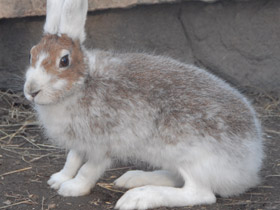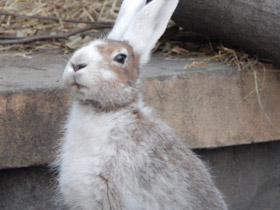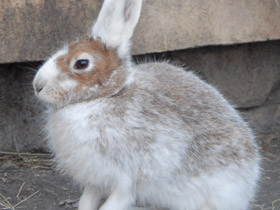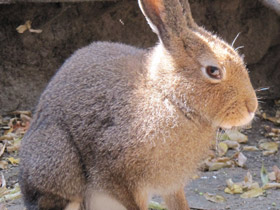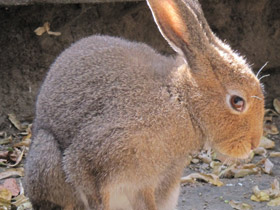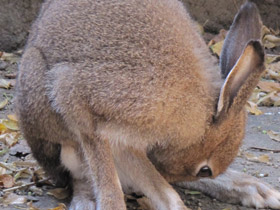The European hare or the brown hare (Lepus europaeus)
The European hare (Lepus europaeus), also known as the brown hare, is a species of hare native to Europe and parts of Asia. It is among the largest hare species and is adapted to temperate, open country. Hares are herbivorous and feed mainly on grasses and herbs, supplementing these with twigs, buds, bark and field crops, particularly in winter. Their natural predators include large birds of prey, canids and felids. They rely on high-speed endurance running to escape predation, having long, powerful limbs and large nostrils.
The European hare (Lepus europaeus) is a species of lagomorphic mammal of the family Leporidae that is among the main game species.
Taxonomy and genetics
The European hare was first described in 1778 by German zoologist Peter Simon Pallas. It shares the genus Lepus (Latin for "hare") with 32 other hare and jackrabbit species, jackrabbits being the name given to some species of hare native to North America. They are distinguished from other leporids (hares and rabbits) by their longer legs and wider nostrils. The Corsican hare, broom hare and Granada hare were at one time considered to be subspecies of the European hare, but DNA sequencing and morphological analysis support their status as separate species.
There is some debate as to whether the European hare and the Cape hare are the same species. A 2005 nuclear gene pool study suggested that they are, but a 2006 study of the mitochondrial DNA of these same animals concluded that they had diverged sufficiently widely to be considered separate species. A 2008 study claims that in the case of Lepus species, with their rapid evolution, species designation cannot be based solely on mtDNA but should also include an examination of the nuclear gene pool. It is possible that the genetic differences between the European and Cape hare are due to geographic separation rather than actual divergence. It has been speculated that in the Near East, hare populations are intergrading and experiencing gene flow. Another 2008 study suggests that more research is needed before a conclusion is reached as to whether a species complex exists; the European hare remains classified as a single species until further data contradicts this assumption.
Cladogenetic analysis suggests that European hares survived the last glacial period during the Pleistocene via refugia in southern Europe (Italian peninsula and Balkans) and Asia Minor. Subsequent colonisations of Central Europe appear to have been initiated by human-caused environmental changes. Genetic diversity in current populations is high with no signs of inbreeding. Gene flow appears to be biased towards males, but overall populations are matrilineally structured. There appears to be a particularly large degree of genetic diversity in hares in the North Rhine-Westphalia region of Germany. It is however possible that restricted gene flow could reduce genetic diversity within populations that become isolated.
Historically, up to 30 subspecies of European hare have been described, although their status has been disputed. These subspecies have been distinguished by differences in pelage colouration, body size, external body measurements, skull morphology and tooth shape.
Sixteen subspecies are listed in the IUCN red book, following Hoffmann and Smith (2005):
- Lepus europaeus caspicus;
- Lepus europaeus connori;
- Lepus europaeus creticus;
- Lepus europaeus cyprius;
- Lepus europaeus cyrensis;
- Lepus europaeus europaeus;
- Lepus europaeus hybridus;
- Lepus europaeus judeae;
- Lepus europaeus karpathorum;
- Lepus europaeus medius;
- Lepus europaeus occidentalis;
- Lepus europaeus parnassius;
- Lepus europaeus ponticus;
- Lepus europaeus rhodius;
- Lepus europaeus syriacus;
- Lepus europaeus transsylvanicus.
Twenty-nine subspecies of "very variable status" are listed by Chapman and Flux in their book on lagomorphs, including the subspecies above (with the exceptions of Lepus europaeus connori, Lepus europaeus creticus, Lepus europaeus cyprius, Lepus europaeus judeae, Lepus europaeus rhodius, and Lepus europaeus syriacus) and additionally:
- Lepus europaeus alba;
- Lepus europaeus argenteogrisea;
- Lepus europaeus biarmicus;
- Lepus europaeus borealis;
- Lepus europaeus caspicus;
- Lepus europaeus caucasicus;
- Lepus europaeus flavus;
- Lepus europaeus gallaecius;
- Lepus europaeus hispanicus;
- Lepus europaeus hyemalis;
- Lepus europaeus granatensis;
- Lepus europaeus iturissius;
- Lepus europaeus kalmykorum;
- Lepus europaeus meridiei;
- Lepus europaeus meridionalis;
- Lepus europaeus niethammeri;
- Lepus europaeus niger;
- Lepus europaeus tesquorum;
- Lepus europaeus tumak.
Distribution and feeding behaviour
Lepus europaeus is somewhat larger than the squirrel (body length 57-68 cm, weight up to 7 kg). It inhabits Asia Minor, Europe and North Africa; in Russia it is found in the European and northern parts of the country, where it inhabits steppes, fields and meadows. Lepus europaeus has a frail build, long ears, wedge-shaped, black or black-brown tail from above. The feet of Lepus europaeus are not as wide as those of the squirrel, but very long (up to 18.5 cm), which makes it run faster. Lepus europaeus feeds on the wood and bark of maple, oak and hazel trees if deep snow cover is established.
Reproduction
The mating season of Lepus europaeus begins in early March; in mild winters, in February and even January. Pregnancy of the hare lasts about 45-50 days. Usually she gives birth for the first time between mid- and late March, the fourth and last time in August; the first litter consists of one or two cubs, the second of three or four, the third of three, and the fourth again of one or two, in exceptional cases five or more cubs are born at once. The births take place in some secluded place in the forest or field: on a heap of dung, in a hollow of an old log, covered with leaves. Cubs are born well-developed, with open eyes. The mother stays with them for the first 5-6 days, then she only returns from time to time to feed them. The cubs are fully grown by 15 months of age, but are already capable of reproduction in the first year of life.
Predation
They are common prey for wolves (Canis lupus), foxes (Vulpes vulpes), wild cats (Felis silvestris) and large birds of prey.
Pathologies
They suffer from various diseases, favoured by repopulation, the brown hare syndrome, which has caused high mortalities in Europe and arrived in Spain in 1991, and tularemia, a dangerous disease due to its possible transmission to humans.

















